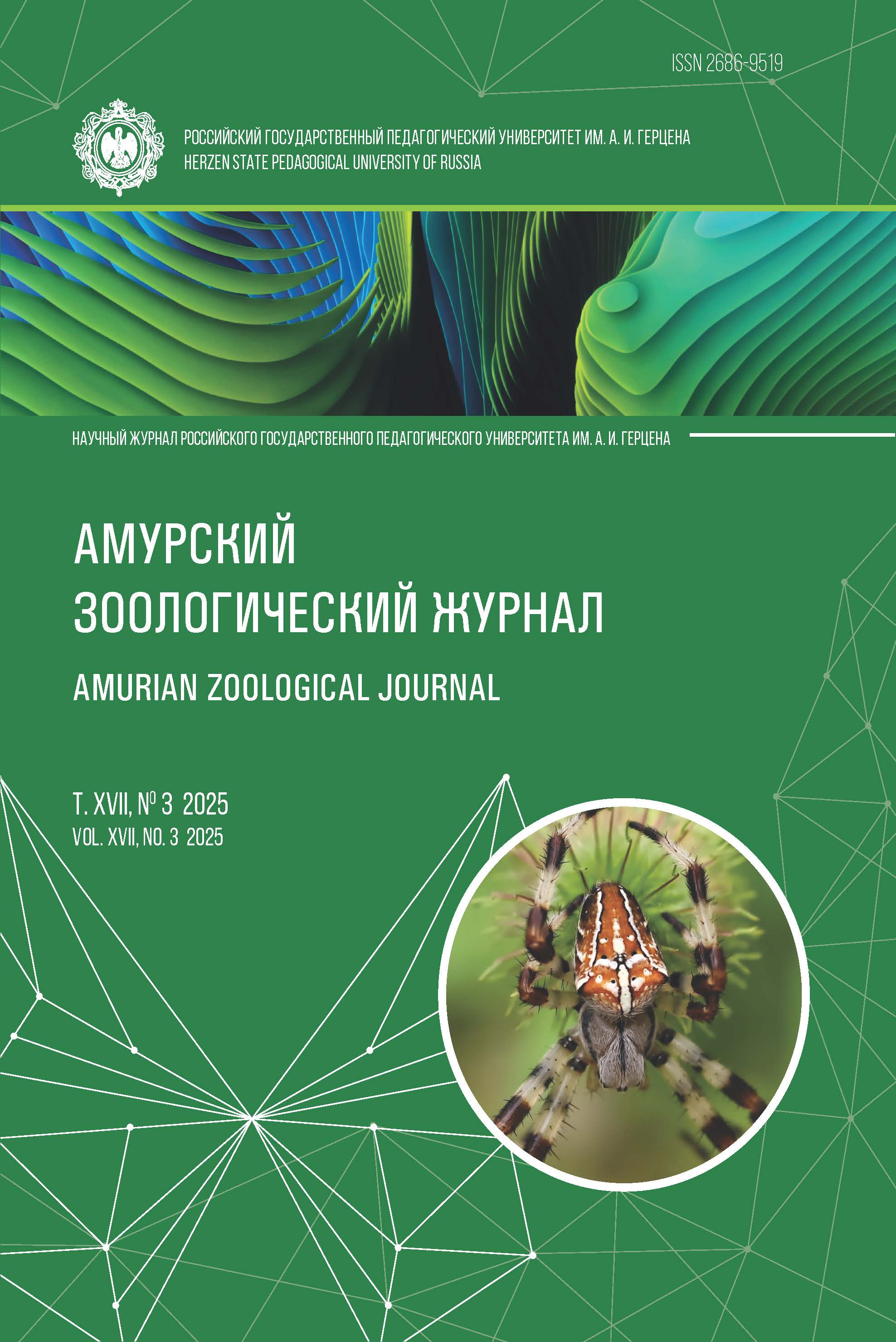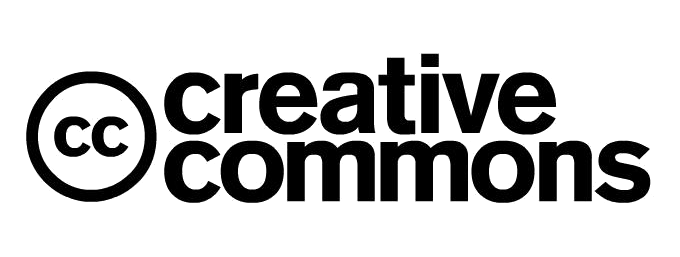Use of ungulate feeding grounds by birds in the V. L. Komarov Ussuriysky State Nature Reserve
DOI:
https://doi.org/10.33910/2686-9519-2025-17-3-449-464Keywords:
avifauna, feeding grounds, game breeding, Southern Primorsky Krai, Russian Far East, Ussuriysky Nature ReserveAbstract
The creation of feeding grounds for ungulates is a widespread practice globally, used in both game management and protected areas. These sites become integrated into natural ecosystems and assume significant cenotic roles. They actively influence the organization of zoocenoses, including various bird species. This function of ungulate feeding grounds is poorly documented in the scientific literature, particularly in Russian publications. This article analyzes data from camera traps deployed at feeding grounds in the V. L. Komarov Ussuriysky State Nature Reserve (Primorsky Krai). The survey effort totaled 493 camera-trap days. We recorded 785 independent bird observations, comprising 1,430 individuals from 19 species, ten families, and five orders. Species richness was highest in spring (15 species) and winter (10 species), with only 2 species recorded in summer and 1 in autumn. The high spring diversity is attributed to the arrival and passage of migratory species that utilize the feeding grounds. The most frequent visitors in winter were Eurasian nuthatches (30.8 % of records), Eurasian jays (24.4 %), marsh tits (21.0 %) and large-billed crows (10.5%). In spring, most common were marsh and willow tits (28.3 %), followed by jays (27.0%), nuthatches (14.5%) and yellow-throated buntings (12.0 %). Birds scarcely visited the feeding grounds in summer and autumn.
References
ЛИТЕРАТУРА
Абрамов, В. К., Костенко, В. А., Нестеренко, В. А., Тиунов, М. П. (2003) Млекопитающие. В кн.: М. Н. Литвинов (ред.). Позвоночные животные Уссурийского государственного заповедника: аннотированный список видов. Владивосток: Дальнаука, с. 72–86.
Агафонов, Г. М., Болдырев, Д. А., Бородин, Г. А. (2024) Птицы на солонцах для копытных. Русский орнитологический журнал, т. 33, № 2433, с. 2937–2939.
Берсенев, Ю. И. (2017) Особо охраняемые природные территории Приморского края: существующие и проектируемые. Владивосток: Изд-во Дальневосточного федерального университета, 202 с.
Гапонов, В. В. (2006) Научные основы увеличения численности диких копытных на юге Дальнего Востока. Владивосток: Дальнаука, 49 с.
Дежкин, В. В., Калецкий, А. А. (1973) Под пологом леса (К совместному ведению лесного и охотничьего хозяйств). М.: Лесная промышленность, 160 с.
Дицевич, Б. Н. (2007) Пути повышения численности диких копытных животных. Владивосток: Дальнаука, 56 с.
Жабыко, Е. В. (2006) Лесная растительность. В кн.: Л. Н. Васильева (ред.). Флора, растительность и микобиота заповедника «Уссурийский». Владивосток: Дальнаука, с. 15–29.
Злобин, Б. Д. (1985) Подкормка охотничьих животных. М.: Агропромиздат, 143 с.
Коньков, А. Ю. (2001) Увеличение численности пятнистого оленя в Лазовском заповеднике и его последствия. В кн.: В. П. Селедец (ред.). V Дальневосточная конференция по заповедному делу. Владивосток: Дальнаука, с. 152–154.
Корелов, М. Н. (2002) Птичьи солонцы. Русский орнитологический журнал, т. 11, № 172, с. 44–46.
Кузнецов, Б. А. (1974) Биотехнические мероприятия в охотничьем хозяйстве. 2-е изд. М.: Лесная промышленность, 223 с.
Маковкин, Л. И. (1999) Дикий пятнистый олень Лазовского заповедника и сопредельных территорий. Владивосток: Русский Остров, 133 с.
Маслов, М. В. (2009) Акклиматизация пятнистого оленя — Cervus nippon (Temm., 1838) — на территории Уссурийского заповедника: история и современное состояние. Вестник Оренбургского государственного университета, № 10 (104), с. 123–129. https://doi.org/10.25198/1814-6457-104-123
Маслов, М. В. (2012) Трансформация естественных местообитаний и изменение состояния популяций копытных Уссурийского заповедника и прилежащих территорий под влиянием антропогенного пресса. Научные ведомости Белгородского государственного университета. Серия: Естественные науки, № 21 (140), с. 82–88.
Маслов, М. В., Маркова, Т. О., Литвинова, Е. А., Литвинов, М. Н. (2024) Влияние интродукции пятнистого оленя на современное состояние численности и распределение копытных млекопитающих в Уссурийском заповеднике (Дальний Восток России). Сибирский экологический журнал, т. 31, № 6, с. 913–922. https://doi.org/10.15372/SEJ20240607
Нечаев, В. А., Курдюков, А. Б., Харченко, В. А. (2003) Птицы. В кн.: М. Н. Литвинов (ред.). Позвоночные животные Уссурийского государственного заповедника: аннотированный список видов. Владивосток: Дальнаука, с. 31–71.
Степанов, М. А., Виноградов, А. А. (2008) Птицы подкормочных площадок охотхозяйства Тверьохотобъединения «Егерь». Вестник Тверского государственного университета. Серия: Биология и экология, вып. 10, с. 121–126.
Фертиков, В. И., Жуков, Д. В., Мануш, П. С., Кручинин, В. Д. (2018) Роль подкормочных площадок для копытных животных в экосистемах национального парка «Завидово». Вестник Тверского государственного университета. Серия: Биология и экология, № 2, с. 111–121.
Харченко, Н. Н. (2002) Охотоведение. М.: Изд-во Московского государственного университета леса, 371 с.
Юргенсон, П. Б. (1973) Биологические основы охотничьего хозяйства в лесах. М.: Лесная промышленность, 176 с.
Bordjan, D., Soultan, A., Jerina, K. (2023) Temporal occurrence and species composition of birds on artificial feeding sites maintained for game mammals in the Dinaric Mountains, Slovenia. Ornis Fennica, vol. 100, no. 2, pp. 84–98. https://doi.org/10.51812/of.121820
Bowman, B., Belant, J. L., Beyer Jr., D. E., Martel, D. (2015) Characterizing nontarget species use at bait sites for white-tailed deer. Human–Wildlife Interactions, vol. 9, no. 1, pp. 110–118. https://doi.org/10.26077/6n16-pf76
Candler, E. M., Severud, W. J., Bump, J. K. (2019) Who takes the bait? Non-target species use of bear hunter bait sites. Human–Wildlife Interactions, vol. 13, no. 1, pp. 98–110. https://doi.org/10.26076/49xm-fx57
Casey, D., Hein, D. (1983) Effects of heavy browsing on a bird community in deciduous forest. The Journal of Wildlife Management, vol. 47, no. 3, pp. 829–836. https://doi.org/10.2307/3808620
DeCalesta, D. S. (1994) Effect of white-tailed deer on songbirds within managed forests in Pennsylvania. The Journal of Wildlife Management, vol. 58, no. 4, pp. 711–718. https://doi.org/10.2307/3809685
DeGraaf, R. M., Healy, W. M., Brooks, R. T. (1991) Effects of thinning and deer browsing on breeding birds in New England oak woodlands. Forest Ecology and Management, vol. 41, no. 3–4, pp. 179–191. https://doi.org/10.1016/0378-1127(91)90102-2
Fležar, U., Costa, B., Bordjan, D. et al. (2019) Free food for everyone: Artificial feeding of brown bears provides food for many non-target species. European Journal of Wildlife Research, no. 65, article 1. https://doi.org/10.1007/s10344-018-1237-3
Jones, D. N., Reynolds, S. J. (2008) Feeding birds in our towns and cities: A global research opportunity. Journal of Avian Biology, vol. 39, no. 3, pp. 265–271. https://doi.org/10.1111/j.0908-8857.2008.04271.x
Lambert Jr., B. C., Demarais, S. (2001) Use of supplemental feed for ungulates by non-target species. The Southwestern Naturalist, vol. 46, no. 1, pp. 118–121. https://doi.org/10.2307/3672387
Milner, J. M., van Beest, F. M., Schmidt, K. T. et al. (2014) To feed or not to feed? Evidence of the intended and unintended effects of feeding wild ungulates. The Journal of Wildlife Management, vol. 78, no. 8, pp. 1322–1334. https://doi.org/10.1002/jwmg.798
Robb, G. N., McDonald, R. A., Chamberlain, D. E., Bearhop, S. (2008) Food for thought: Supplementary feeding as a driver of ecological change in avian populations. Frontiers in Ecology and the Environment, vol. 6, no. 9, pp. 476–484. https://doi.org/10.1890/060152
Selva, N., Berezowska-Cnota, T., Elguero-Claramunt, I. (2014) Unforeseen effects of supplementary feeding: Ungulate baiting sites as hotspots for ground-nest predation. PLoS ONE, vol. 9, no. 3, article e90740. https://doi.org/10.1371/journal.pone.0090740
REFERENCES
Abramov, V. K., Kostenko, V. A., Nesterenko, V. A., Tiunov, M. P. (2003) Mlekopitayushchie [Mammals]. In: M. N. Litvinov (ed.). Pozvonochnye zhivotnye Ussurijskogo gosudarstvennogo zapovednika: annotirovannyj spisok vidov [Vertebrates of the Ussurisky Nature Reserve: An annotated list of species]. Vladivostok: Dalnauka Publ., pp. 72–86. (In Russian)
Agafonov, G. M., Boldyrev, D. A., Borodin, G. A. (2024) Ptitsy na solontsakh dlya kopytnykh [Birds on salt pans for ungulates]. Russkij ornitologicheskij zhurnal — The Russian Journal of Ornithology, vol. 33, no. 2433, pp. 2937–2939. (In Russian)
Bersenev, Yu. I. (2017) Osobo okhranyaemye prirodnye territorii Primorskogo kraya: sushchestvuyushchie i proektiruemye [Specially protected natural areas of Primorsky Krai: Existing and projected]. Vladivostok: Far Eastern Federal University Publ., 202 p. (In Russian)
Bordjan, D., Soultan, A., Jerina, K. (2023) Temporal occurrence and species composition of birds on artificial feeding sites maintained for game mammals in the Dinaric Mountains, Slovenia. Ornis Fennica, vol. 100, no. 2, pp. 84–98. https://doi.org/10.51812/of.121820 (In English)
Bowman, B., Belant, J. L., Beyer Jr., D. E., Martel, D. (2015) Characterizing nontarget species use at bait sites for white-tailed deer. Human–Wildlife Interactions, vol. 9, no. 1, pp. 110–118. https://doi.org/10.26077/6n16-pf76 (In English)
Candler, E. M., Severud, W. J., Bump, J. K. (2019) Who takes the bait? Non-target species use of bear hunter bait sites. Human–Wildlife Interactions, vol. 13, no. 1, pp. 98–110. https://doi.org/10.26076/49xm-fx57 (In English)
Casey, D., Hein, D. (1983) Effects of heavy browsing on a bird community in deciduous forest. The Journal of Wildlife Management, vol. 47, no. 3, pp. 829–836. https://doi.org/10.2307/3808620 (In English)
DeCalesta, D. S. (1994) Effect of white-tailed deer on songbirds within managed forests in Pennsylvania. The Journal of Wildlife Management, vol. 58, no. 4, pp. 711–718. https://doi.org/10.2307/3809685 (In English)
DeGraaf, R. M., Healy, W. M., Brooks, R. T. (1991) Effects of thinning and deer browsing on breeding birds in New England oak woodlands. Forest Ecology and Management, vol. 41, no. 3–4, pp. 179–191. https://doi.org/10.1016/0378-1127(91)90102-2 (In English)
Dezhkin, V. V., Kaletsky, A. A. (1973) Pod pologom lesa (K sovmestnomu vedeniyu lesnogo i okhotnich’ego khozyajstv) [Under the canopy of the forest (Towards joint management of forestry and hunting)]. Moscow: Lesnaya promyshlennost’ Publ., 160 p. (In Russian)
Ditsevich, B. N. (2007) Puti povysheniya chislennosti dikikh kopytnykh zhivotnykh [Ways to increase the number of wild ungulates]. Vladivostok: Dalnauka Publ., 56 p. (In Russian)
Fertikov, V. I., Zhukov, D. V., Manush, P. S., Kruchinin, V. D. (2018) Rol’ podkormochnykh ploshchadok dlya kopytnykh zhivotnykh v ekosistemakh natsional’nogo parka “Zavidovo” [The role of ungulate feeding grounds in the ecosystems of the Zavidovo National Park]. Vestnik Tverskogo gosudarstvennogo universiteta. Seriya: Biologiya i ekologiya — Vestnik of Tver State University. Series: Biology and Ecology, no. 2, pp. 111–121. (In Russian)
Fležar, U., Costa, B., Bordjan, D. et al. (2019) Free food for everyone: Artificial feeding of brown bears provides food for many non-target species. European Journal of Wildlife Research, no. 65, article 1. https://doi.org/10.1007/s10344-018-1237-3 (In English)
Gaponov, V. V. (2006) Nauchnye osnovy uvelicheniya chislennosti kopytnykh na yuge Dal’nego Vostoka [The scientific basis for increasing the number of ungulates in the south of the Far East]. Vladivostok: Dalnauka Publ., 49 p. (In Russian)
Jones, D. N., Reynolds, S. J. (2008) Feeding birds in our towns and cities: A global research opportunity. Journal of Avian Biology, vol. 39, no. 3, pp. 265–271. https://doi.org/10.1111/j.0908-8857.2008.04271.x (In English)
Kharchenko, N. N. (2002) Okhotovedenie [Game management]. Moscow: Moscow State Forest University Publ., 371 p. (In Russian)
Korelov, M. N. (2002) Ptich’i solontsy [Bird “solonets” (mineral sources)]. Russkij ornitologicheskij zhurnal — The Russian Journal of Ornithology, vol. 11, no. 172, pp. 44–46. (In Russian)
Kon’kov, A. Yu. (2001) Uvelichenie chislennosti pyatnistogo olenya v Lazovskom zapovednike i ego posledstviya [The increase in the number of sika deer in the Lazovsky Nature Reserve and its consequences]. In: V. P. Seledets (ed.). V Dal’nevostochnaya konferentsiya po zapovednomu delu [V Far-Eastern conference on nature conservation problems]. Vladivostok: Dalnauka Publ., pp. 152–154. (In Russian)
Kuznetsov, B. A. (1974) Biotekhnicheskie meropriyatiya v okhotnich’em khozyajstve [Biotechnical activities in the hunting grounds]. 2nd ed. Moscow: Lesnaya promyshlennost’ Publ., 223 p. (In Russian)
Lambert Jr., B. C., Demarais, S. (2001) Use of supplemental feed for ungulates by non-target species. The Southwestern Naturalist, vol. 46, no. 1, pp. 118–121. https://doi.org/10.2307/3672387 (In English)
Makovkin, L. I. (1999) Dikij pyatnistyj olen’ Lazovskogo zapovednika i sopredel’nykh territorij [The sika deer of Lazovsky reserve and surrounding areas of the Russian Far East]. Vladivostok: Russkij Ostrov Publ., 133 p. (In Russian)
Maslov, M. V. (2009) Akklimatizatsiya pyatnistogo olenya — Cervus nippon (Temm., 1838) — na territorii Ussurijskogo zapovednika: istoriya i sovremennoe sostoyanie [Acclimatization of sika deer — Cervus nippon (Temm., 1838) — on the territory of Ussuriyskiy reserve: History and modern condition]. Vestnik Orenburgskogo gosudarstvennogo universiteta — Vestnik of the Orenburg State University, no. 10 (104), pp. 123–129. https://doi.org/10.25198/1814-6457-104-123 (In Russian)
Maslov, M. V. (2012) Transformatsiya estestvennykh mestoobitanij i izmenenie sostoyaniya populyatsij kopytnykh Ussurijskogo zapovednika i prilezhashchikh territorij pod vliyaniem antropogennogo pressa [Transformation of natural habitats and change of the populations condition of hoofed animals of the Ussuriysk reserve and adjacent territories under the influence of the anthropogenic press]. Nauchnye vedomosti Belgorodskogo gosudarstvennogo universiteta. Seriya: Estestvennye nauki — Belgorod State University Scientific Bulletin. Natural Sciences, no. 21 (140), pp. 82–88. (In Russian)
Maslov, M. V., Markova, T. O., Litvinova, E. A., Litvinov, M. N. (2024) Vliyanie introduktsii pyatnistogo olenya na sovremennoe sostoyanie chislennosti i raspredelenie kopytnykh mlekopitayushchikh v Ussurijskom zapovednike (Dal’nij Vostok Rossii) [The influence of the introduction of sika deer on the current state of the number and distribution of ungulate mammals in the Ussuriysky Nature Reserve (Russian Far East)]. Sibirskij ekologicheskij zhurnal — Contemporary Problems of Ecology, vol. 17, no. 6, pp. 830–838. https://doi.org/10.1134/S1995425524700586 (In Russian)
Milner, J. M., van Beest, F. M., Schmidt, K. T. et al. (2014) To feed or not to feed? Evidence of the intended and unintended effects of feeding wild ungulates. The Journal of Wildlife Management, vol. 78, no. 8, pp. 1322–1334. https://doi.org/10.1002/jwmg.798 (In English)
Nechaev, V. A., Kurdyukov, A. B., Kharchenko, V. A. (2003) Ptitsy [Birds]. In: M. N. Litvinov (ed.). Pozvonochnye zhivotnye Ussurijskogo gosudarstvennogo zapovednika: annotirovannyj spisok vidov [Vertebrates of the Ussurisky Nature Reserve: An annotated list of species]. Vladivostok: Dalnauka Publ., pp. 31–71. (In Russian)
Robb, G. N., McDonald, R. A., Chamberlain, D. E., Bearhop, S. (2008) Food for thought: Supplementary feeding as a driver of ecological change in avian populations. Frontiers in Ecology and the Environment, vol. 6, no. 9, pp. 476–484. https://doi.org/10.1890/060152 (In English)
Selva, N., Berezowska-Cnota, T., Elguero-Claramunt, I. (2014) Unforeseen effects of supplementary feeding: Ungulate baiting sites as hotspots for ground-nest predation. PLoS ONE, vol. 9, no. 3, article e90740. https://doi.org/10.1371/journal.pone.0090740 (In English)
Stepanov, M. A., Vinogradov, A. A. (2008) Ptitsy podkormochnykh ploshchadok okhothozyajstva Tver’okhotob’edineniya “Eger’” [The birds from nutrition grounds of hunting ground of Tverokhotobjedinenie “Eger”]. Vestnik Tverskogo gosudarstvennogo universiteta. Seriya: Biologiya i ekologiya — Herald of Tver State University. Series: Biology and Ecology, no. 10, pp. 121–126. (In Russian)
Yurgenson, P. B. (1973) Biologicheskie osnovy okhotnich’ego khozyajstva v lesakh [Biological bases of hunting economy in forests]. Moscow: Lesnaya promyshlennost’ Publ., 176 p. (In Russian)
Zhabyko, E. V. (2006) Lesnaya rastitel’nost’ [Forest vegetation]. In: L. N. Vasilyeva (ed.). Flora, rastitel’nost’ i mikobiota zapovednika “Ussurijskij” [Flora, vegetation and mycobiota of the reserve”Ussuriysky”]. Vladivostok: Dalnauka Publ., pp. 15–29. (In Russian)
Zlobin, B. D. (1985) Podkormka okhotnich’ikh zhivotnykh [Feeding of game animals]. Moscow: Agropromizdat Publ., 143 p. (In Russian)
Downloads
Published
Issue
Section
License
Copyright (c) 2025 Dmitry A. Belyaev, Mikhail V. Maslov

This work is licensed under a Creative Commons Attribution-NonCommercial 4.0 International License.
The work is provided under the terms of the Public Offer and of Creative Commons public license Attribution-NonCommercial 4.0 International (CC BY-NC 4.0). This license allows an unlimited number of persons to reproduce and share the Licensed Material in all media and formats. Any use of the Licensed Material shall contain an identification of its Creator(s) and must be for non-commercial purposes only.







